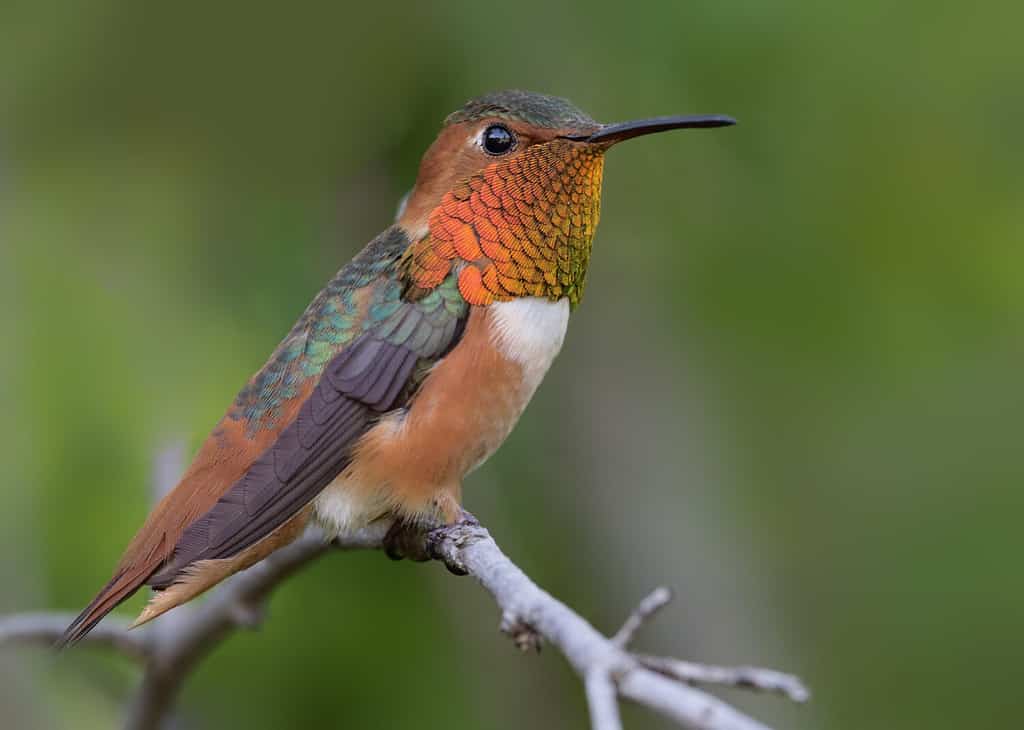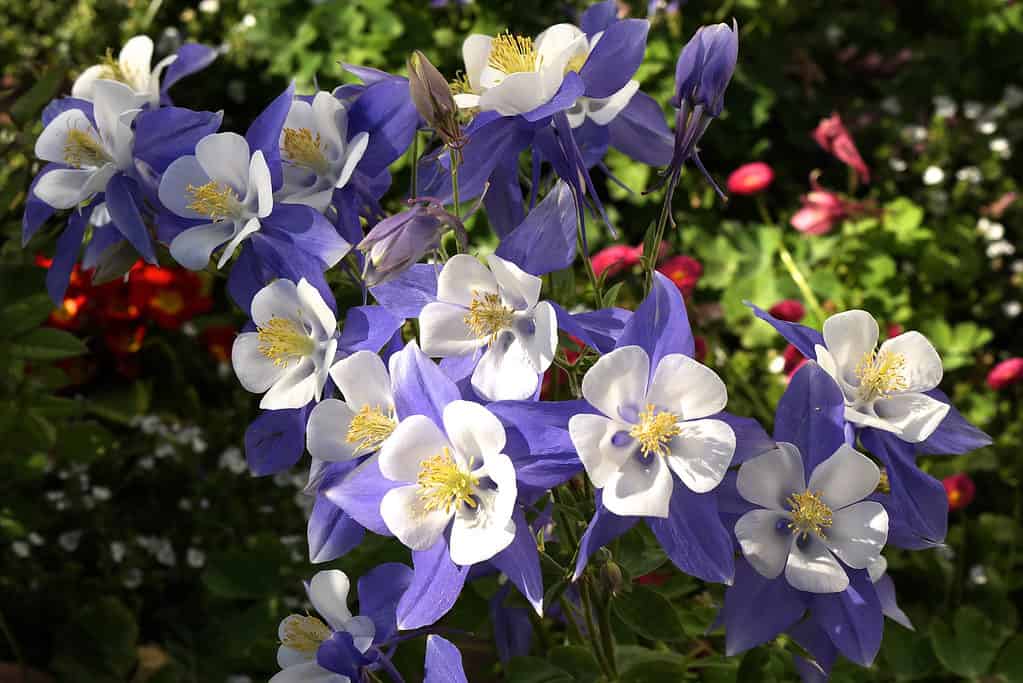Hummingbirds are very fast animals. Their wings beat 80 times per second, and their heart beats up to 1,260 beats per minute. But their wings and circulatory systems aren’t the only things that are speedy. Hummingbirds have one of the fastest metabolisms of any animal on the planet. In fact, their metabolisms are over 75 times faster than a human’s and almost 100 times faster than an elephant’s.
Hummingbirds are tiny (only 3-4 grams in weight), but supporting such high metabolisms requires a lot of calories. If it were a person, a hummingbird would need to consume over 150,000 calories a day! This means hummingbirds are always on the lookout for food. Even half an hour of rest can burn so many calories that some hummingbirds die in their sleep.

How Hummingbirds Build Energy

As omnivores, hummingbirds eat a variety of foods.
©Angel DiBilio/Shutterstock.com
Hummingbirds eat up to two times their body weight in food every day to stay fueled. Many people think hummingbirds only drink nectar from plants or hummingbird feeders, but these little birds are omnivores and eat a variety of foods. This includes spiders and insects such as gnats, flies, mosquitoes, and ants. In fact, a hummingbird’s diet is mostly insects, and they often catch insects mid-air.
Hummingbirds also need sugar to sustain their high metabolism, and that’s where flower nectar comes in. Hummingbirds prefer flowers with nectar that has high sugar content, and they will reject flowers with nectar that doesn’t meet their standards. Many people put out hummingbird feeders filled with sugar water to replicate nectar. Sugar water mixtures are easy to make, and just require a 1:4 ratio of sugar and water.
Hummingbirds aren’t picky about their sugar, but sugar water mixtures should only be made with refined white sugar. You should never use other sugars, honey, sugar substitutes, or corn syrup. This is because they may contain additives that could harm a hummingbird. While people often add red dye to sugar water, the chemicals in red dye #40 can be bad for hummingbirds. Luckily, while the color red attracts hummingbirds, sugar water is enough to get their attention without red coloring.
Sugar water is an easy way to feed hummingbirds, but there are other things that attract the birds and provide a much-needed food source. Here are four options to consider to attract more hummingbirds to your yard and offer an alternative to sugar water.
#1: Plant Nectar

Columbine flowers are a popular choice for hummingbirds because of their shape and color.
©iStock.com/Linda Jo Heilman
Hummingbirds enjoy the sugar water in hummingbird feeders, but their primary natural source for nectar is flowers. Hummingbird migration is seasonal and timed around the bloom schedule of flowers, so that they have plenty of food along the way. The energy from food is critical for migration. because migration is not a short trip. Some species such as rufous hummingbirds travel huge distances, migrating from Mexico to Alaska in the spring, and back again in the fall. The ruby-throated hummingbird often flies 18-20 hours straight without stopping to cross the Gulf of Mexico.
Hummingbirds migrate twice a year, so planting both early- and late-blooming flowers in your garden can help feed them on their long journey. The birds look for nectar with an average sugar content of around 26 percent (almost double the amount of sugar found in a soda!). The nectar can’t be too thick or sticky, or the hummingbirds will be unable to drink it.
In addition to nectar, the shape of the flower can attract or deter a hummingbird. Hummingbirds look for flowers that are tubular and long in shape, so they can easily reach their tongue and bill inside to feed. Easily visible, bright colors such as red or orange are also attractive to hummingbirds. Popular plants with hummingbirds include coral honeysuckle, cardinal flowers, columbine, bee balms, and butterfly bushes.
#2: Insects

Insects make up 80 percent of a hummingbird’s diet.
©Alexlky/Shutterstock.com
Attracting insects to your garden may not seem like a great idea, but hummingbirds love areas with high concentrations of bugs for them to eat. Sugar water feeders often attract ants, which frustrates many people. However, insects are just a second meal opportunity for hummingbirds. Leaving out ripe or overripe fruit attracts insects that are appealing to hummingbirds, such as ants, gnats, and fruit flies.
If you don’t want to leave overripe fruit in your yard, there are also feeders designed to attract bugs specifically for hummingbirds. These protein feeders have a compartment into which you can insert fruit or banana peels and are similar in appearance to the red sugar-water feeders. The incubating fruit and peels attract fruit flies, which in turn attract hummingbirds.
#3: Fruit

Juicy fruits like oranges provide sugar for hummingbirds, while also attracting protein-rich insects.
©PradaBrown/Shutterstock.com
Fruit isn’t just attractive to insects: It also makes an easy snack for opportunistic hummingbirds, even though it is not a primary food source. However, hummingbirds can only eat juicy fruits, as their beaks are designed for sipping (not chewing or pecking).
Watermelon, berries, apples, oranges, peaches, or pears are all appealing options. Peeling or cutting open the fruit will expose the juicy insides and make it easier for hummingbirds to eat. Browning or overripe bananas are also a draw, but they should be peeled and chopped to make them easier to eat. Even if hummingbirds aren’t attracted to the fruit, the insects will be.
#4: Store-Bought Nectar

Store-bought nectar mixtures often make a less granular liquid, as they are finely ground and mix easier with water than plain sugar.
©Rick Scuteri/Shutterstock.com
Sugar water is the best substitute for natural nectar for hummingbirds, but commercial options are also available. Pre-made options save the work of mixing sugar and water, but many store-bought options contain dyes or additives that can be harmful to birds. If you buy pre-made nectar, ensure it is sucrose-based and dye-free. The best nectars only have sugar and water in them, with nothing else added in. It is usually safer (and less expensive) to just make sugar water at home, rather than purchasing packaged options.
Summary of 4 Foods for Hummingbirds
| Number | Food | Benefits |
|---|---|---|
| 1 | Plant nectar | Natural food source that can beautify gardens |
| 2 | Insects | Good source of protein |
| 3 | Fruit | Provides sugar and attracts insects |
| 4 | Store-bought nectar | Pre-made and convenient to use |
The photo featured at the top of this post is © Ondrej Prosicky/Shutterstock.com
Thank you for reading! Have some feedback for us? Contact the AZ Animals editorial team.







